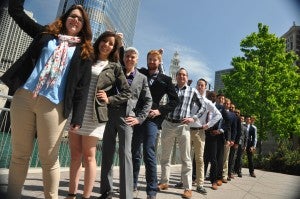By: Rory Christian and Jacob Robinson
 The seventh annual Climate Week NYC has kicked off, and it’s invigorating to reflect on the progress to date since last September when over 400,000 activists demanded bold climate action at the People’s Climate March. During the last year, Environmental Defense Fund (EDF) has continued to observe and nourish the growing appetite among America’s business community to move together on carbon reduction. This movement should not be understated, especially as New York regulators continue to move forward with the “Reforming the Energy Vision” (REV) proceeding.
The seventh annual Climate Week NYC has kicked off, and it’s invigorating to reflect on the progress to date since last September when over 400,000 activists demanded bold climate action at the People’s Climate March. During the last year, Environmental Defense Fund (EDF) has continued to observe and nourish the growing appetite among America’s business community to move together on carbon reduction. This movement should not be understated, especially as New York regulators continue to move forward with the “Reforming the Energy Vision” (REV) proceeding.
Outlined in a set of regulatory proceedings, in which EDF has been deeply embedded, this vision for a cleaner, more affordable energy future has the potential to spur innovation, modernize the electric grid, and transform the century-old electricity system as we know it. If done right, REV will prepare New York for a future in which clean distributed energy resources (DERs) – such as microgrids, rooftop solar, battery storage, energy efficiency, and other on-site energy options – will play an increasingly important role in how the state makes, moves, interacts with, and uses energy.
While it’s important that governments craft the clean energy rulebooks, leadership can and should also come from industry, as EDF’s Tom Murray urged earlier this year. Organizations across sectors are already paving the road for strong regulatory reform that values clean DERs and customer engagement. EDF’s own Climate Corps program is proof of this. But what New York’s business leaders really want is regulatory certainty that the clean energy investments they’re making now – or at least considering –will pay off once NY REV is implemented.
Climate Corps makes the business case
Since the start of the program eight years ago, EDF Climate Corps has deployed over 60 trained fellows across New York at a diversity of organizations – ranging from financial institutions like JPMorgan Chase, to public agencies such as NYC Department of Environment, to community centers like Goddard Riverside. Their work is helping to build the state’s internal capacity for making smart energy management decisions.
The outcomes of EDF’s Climate Corps projects in New York and elsewhere have generated business cases for clean DER projects, like onsite solar and smart metering. In 2014, more than 25 percent of EDF Climate Corps fellowships explored clean energy opportunities, a trend we expect to grow as organizations play an increasing role in electricity markets. In July, 75 plus members of the EDF Climate Corps network, which includes host organizations and fellows, turned out for an event in New York to discuss what REV might enable for organizations and individual consumers. While these examples illustrate a growing appetite for and interest in clean DERs among New York’s business leaders, NY REV could be the regulatory certainty they need to move from investigation to implementation.

EDF Climate Corps fellows have helped organizations in New York and throughout the US move the needle on smart energy management.
Meanwhile, many New York organizations are already acting on clean energy and their early action helps make a case for the removal of regulatory barriers outlined in the REV proceedings. Five-time Climate Corps host, Verizon Communications, has invested over $100 million in clean and renewable energy projects in facilities throughout the country, including a 1.4 megawatt fuel cell in Garden City, New York. When selecting locations for these and other energy projects, Verizon is careful to consider sites with favorable zoning requirements, utility partners, and regulatory regimes. If these conditions are unfavorable, even financially viable projects may be doomed from the onset. These are the exact kind of considerations NY REV aims to address, with the goal of attracting more companies like Verizon to innovate, test, and implement clean energy technology in New York.
[Tweet “Business is ready for “Reforming the Energy Vision” in New York”]
Opportunities and challenges ahead
Skeptics of energy regulatory reform want to ensure the market is prepared to handle and thrive once the proposed REV standards are implemented, while advocates believe New Yorkers are ready and regulatory changes are necessary to remove barriers to adoption of clean energy. Of course, overhauling an energy system that’s been in place for more than 100 years requires significant tenacity and trust that the new models will work. This is the task at hand for those involved in the multi-stakeholder REV proceeding as they take on the significant and tough work of reshaping a centuries’ old utility business model.
If REV is implemented the right way – prioritizing clean distributed energy resources over the dirty kind, like diesel generators – early adopters like the Climate Corps hosts described above will be rewarded and New York will gain a competitive edge. Pro-clean energy businesses will begin to see New York’s favorable regulatory environment as an asset to their bottom lines. To ensure regulators get this right, REV decision makers have taken steps to include business leaders in policy discussions, identifying new opportunities and addressing concerns before the proceedings are made law. This will help make NY REV stronger and more effective in its ability to deliver jobs and economic growth.
Many New York organizations are already doubling down on clean energy – they don’t need REV to tell them it’s a good business investment. But, a little regulatory certainty can go a long way in giving businesses the greenlight they need to speed ahead on the road to a low-carbon economy. Hopefully next year, when climate advocates form all over the world descend again on New York for Climate Week, we can reflect on this time as the moment when New York leaders decided to give the people what they want – a cleaner, more resilient energy system unbridled by outdated laws and regulations.









